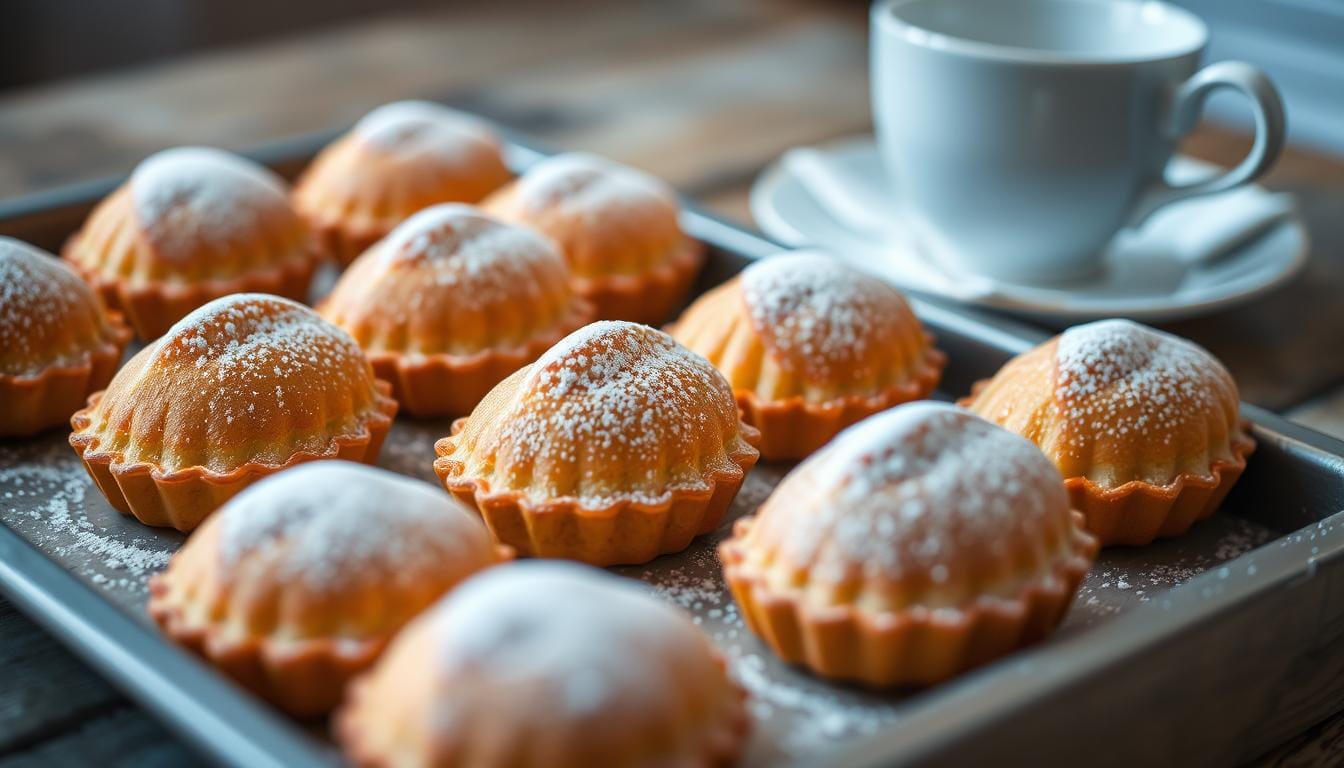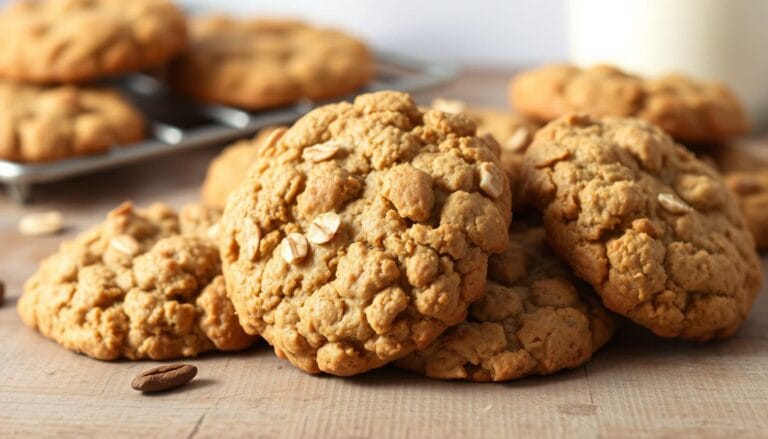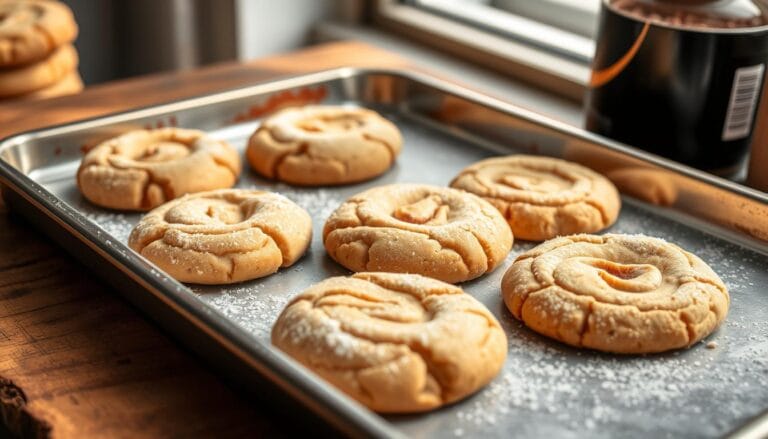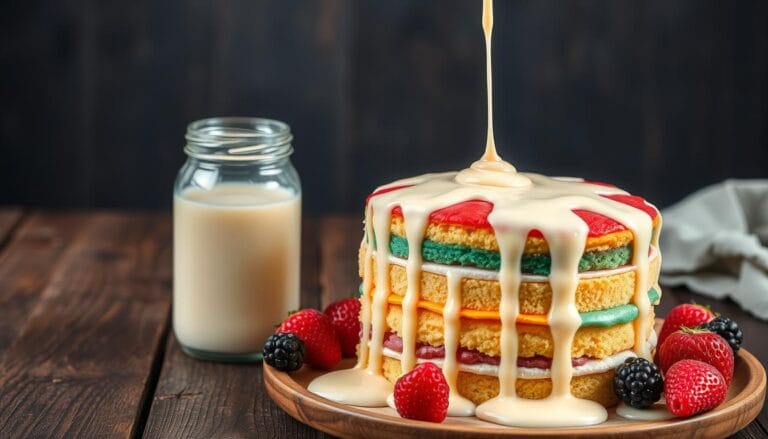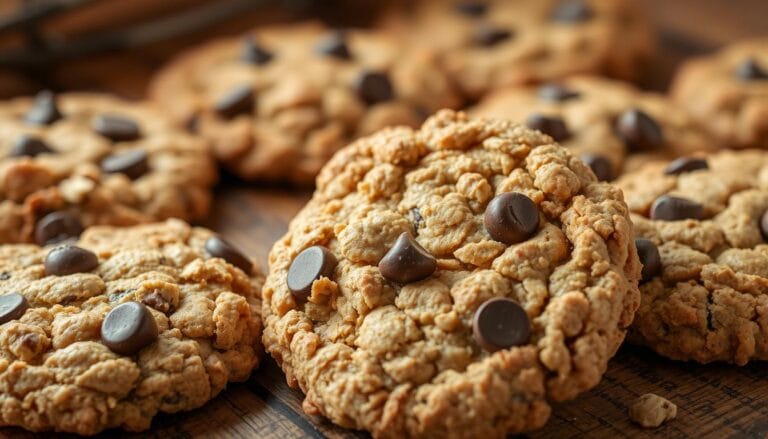How to Make Madeleines
Discover the art of making French pastries that will take you to Paris. Madeleines are elegant shell-shaped cakes that are a classic French dessert. They need precision, patience, and a love for baking.
In this guide, you’ll learn to make authentic madeleines. They have a traditional flavor and texture loved worldwide. We’ll show you how to pick the right ingredients and make the signature shell shape.
Table of Contents
Understanding French Madeleines: History and Tradition
Explore the world of shell-shaped cakes that have won hearts for ages. The madeleine is a key French pastry, mixing art with tradition.
Origins of the Shell-Shaped Delicacy
These cakes come from northeastern France, especially Lorraine. Stories say they were named after Madeleine, a young cook for French nobles.
- Traditional ingredients include butter, sugar, eggs, and flour
- Characterized by a distinctive shell-like shape
- Typically baked in special scalloped molds
The Proust Connection
Proust’s madeleine became famous in In Search of Lost Time. He said a madeleine dipped in tea brought back childhood memories. It became a symbol of nostalgia and taste.
Modern Interpretations
Today, bakers are making new versions of these cakes. They add flavors like lavender and chocolate. Yet, they keep the French essence alive. Chefs mix new tastes with old ways.
A madeleine is more than a cake—it’s a journey through French culinary tradition.
Enjoyed with tea or as a dessert, madeleines connect us across time. They are simple yet elegant, loved by all.
Essential Equipment and Ingredients for Perfect Madeleines
To make delicious lemon-flavored treats and vanilla-scented delights, you need the right tools and ingredients. The most important tool is the madeleine pan. It gives these French treats their unique shell shape.
Your essential equipment includes:
- Madeleine pan with shell-shaped molds
- Electric mixer or whisk
- Mixing bowls
- Sifter for dry ingredients
- Pastry brush for greasing the madeleine pan
For authentic French madeleines, you’ll need these key ingredients:
- Unsalted butter (6 tablespoons)
- Granulated sugar (1/2 cup)
- All-purpose flour (3/4 cup)
- Baking powder (1/2 teaspoon)
- Salt (1/8 teaspoon)
- Fresh lemon zest
- Large eggs (2)
- Pure vanilla extract (1 1/2 teaspoons)
The quality of your ingredients affects the taste and texture of your treats. Use room-temperature eggs and fresh ingredients for the best results. The madeleine pan is key – its molds create the classic look of these treats.
Pro tip: Chill your batter for at least an hour before baking. This helps create the signature madeleine hump and ensures a light, delicate texture for your lemon-flavored treats.
The Art of Brown Butter for Madeleines
Brown butter makes ordinary french pastries into something special. It adds a rich, nutty taste that both chefs and home bakers love.
Brown butter, or beurre noisette in French, needs careful attention. It’s made by heating butter until it turns golden and develops a deep flavor.
Creating Perfect Brown Butter
Here’s how to make amazing brown butter for your madeleines:
- Use unsalted butter at room temperature
- Select a light-colored pan for precise color monitoring
- Cut butter into uniform pieces for even melting
- Cook on medium-low heat, stirring consistently
- Watch for golden brown color and nutty aroma
Temperature and Timing Insights
To master brown butter, know the temperature. Aim for 300-350°F. It usually takes 5-7 minutes.
“Brown butter transforms simple ingredients into culinary poetry” – Renowned Pastry Chef
Storage and Usage Techniques
Let brown butter cool a bit before mixing it into your batter. You can store unused brown butter in the fridge for up to a week in an airtight container.
Pro tip: Strain brown butter through a fine-mesh sieve. This removes milk solids and gives your pastries a smooth flavor.
Preparing Your Madeleine Batter
Making the perfect batter is key to delicious madeleines. These bite-sized treats are perfect for tea snacks. Start by choosing top-notch ingredients and learning the right techniques.
The secret to great madeleines is in the batter’s prep and rest. Bakers say to mix ingredients carefully:
- Sift dry ingredients well for a smooth mix
- Use eggs at room temperature for better mixing
- Fold ingredients gently to keep air in
- Chill the batter for the best results
Chilling the batter is very important. Experts say to chill it for 1-2 hours, or even overnight for more flavor. This lets the flour soak up and the ingredients blend, improving the taste.
Your list should include:
- 175g pastry flour
- 5g baking powder
- 175g melted butter
- 140g sugar
- 30g honey
- 4 small eggs
For tea snacks, try adding lemon zest or vanilla extract. These touches can make your madeleines special. They become a wonderful part of afternoon tea.
Mastering the Signature Shell Shape
Making perfect shell-shaped cakes needs precision and skill. Classic French desserts like madeleines are all about their unique shape and texture. This special design turns these cakes into true works of art.
To make perfect madeleines, you must focus on a few key steps. Getting your pan ready and how you put the batter in are crucial. These steps will help you succeed.
Proper Pan Preparation
Getting your madeleine pan ready is key. Here’s what you need to do:
- Thoroughly clean the shell-shaped molds
- Generously grease each cavity with softened butter
- Dust molds with flour, tapping out excess
- Chill the pan for at least 10 minutes before use
Batter Distribution Techniques
How you put the batter in the pan affects your cakes’ look. Here are some tips:
- Fill each mold 85-90% full
- Use a piping bag for precise distribution
- Gently tap the pan to remove air bubbles
- Ensure even batter coverage in each shell mold
Creating the Classic Hump
The hump is what makes madeleines special. To get it right, follow these steps:
- Chill the batter for 30-60 minutes before baking
- Preheat oven to 400°F (204°C)
- Use a cold pan for best hump formation
- Bake for 9-10 minutes until edges turn golden
Pro tip: The sudden temperature change between cold batter and hot pan creates the signature madeleine hump, making your shell-shaped cakes truly authentic.
Baking Temperature and Timing Secrets
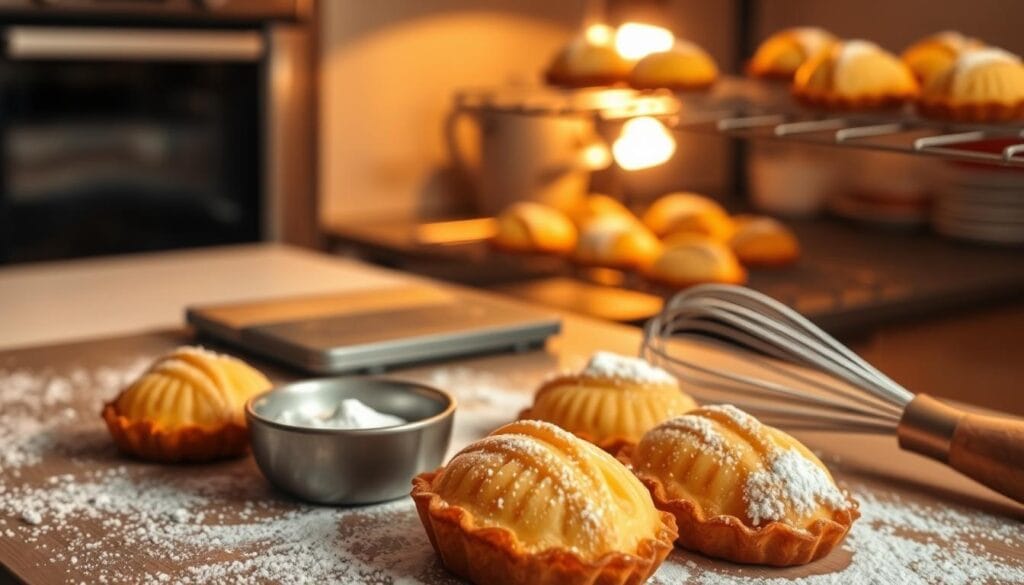
Baking madeleines is all about precision and care. These French pastries need the right temperature to get their golden outside and soft inside. The perfect baking temperature is 375°F (190°C), turning your batter into tasty treats.
Success in baking depends on a few key timing factors:
- Preheat the oven to exactly 375°F
- Bake for 9-11 minutes
- Watch for golden brown edges
- Check for a light spring-back when touched
Professional bakers use a special two-stage baking method for madeleines. First, bake at 400°F for 4-5 minutes to form the hump. Then, lower the temperature to 375°F for 5-7 more minutes. This method helps your madeleines get their classic shape and soft texture.
Temperature changes can greatly affect your baking. If it’s too hot, your madeleines will be dry and crumbly. If it’s too cold, they won’t have the golden color and crisp edges that make them so appealing.
Pro tip: Chill your madeleine pan in the freezer for 10 minutes before adding batter. This step helps create perfect shells with defined ridges and a beautiful golden sheen.
Classic Flavor Variations and Additions
Make your bite-sized sweets more exciting with new madeleine flavors. Try citrus twists or rich chocolate versions. These classic French cookies are perfect for creative cooking.
Citrus Infusions for Lemon-Flavored Treats
Give your madeleines a fresh twist with citrus. Lemon treats can get a boost from:
- Fresh lemon zest (2 tablespoons)
- Orange blossom water
- Tangerine or bergamot zest
Vanilla and Spice Delights
Try vanilla-scented madeleines with different vanilla types and spices. Here are some ideas:
- Madagascar vanilla bean
- Ground cinnamon (1 teaspoon)
- Freshly grated nutmeg (1/2 teaspoon)
Pro tip: Always use high-quality vanilla extract for the most authentic flavor profile.
Decadent Chocolate Variations
Chocolate lovers will enjoy these madeleine flavors. Try these:
- Unsweetened cocoa powder (2 tablespoons)
- Melted bittersweet chocolate (8 ounces)
- Dark chocolate chips
Each twist gives a new spin on the classic madeleine. You can mix flavors while keeping the cookie’s soft texture.
Decorating and Serving Your Madeleines
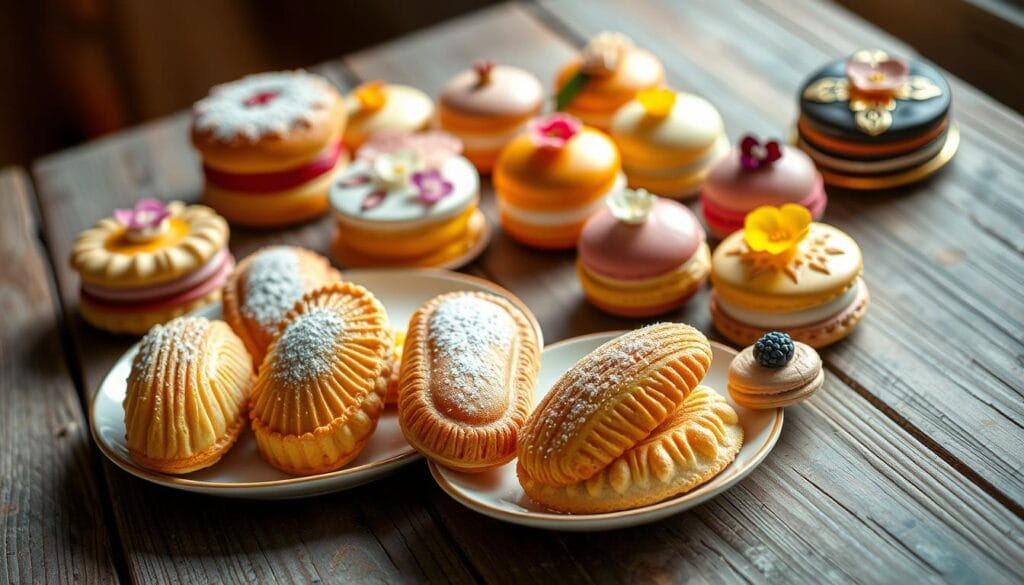
Turn your classic French pastries into stunning tea snacks with creative decoration. Madeleines are a blank canvas for culinary artistry. They can go from simple desserts to impressive delicacies.
Decorating madeleines is both fun and easy. Here are some elegant ways to enhance your classic French desserts:
- Dust with powdered sugar for a simple, elegant finish
- Dip in melted candy melts for vibrant colors
- Drizzle with chocolate glaze
- Sprinkle with seasonal spices like cinnamon or pumpkin pie blend
For a professional touch, try Carla Hall’s candy melts technique. These versatile coatings come in many colors and skip the complex chocolate tempering. Melt them in short microwave bursts at 50% power, then dip or drizzle your madeleines.
Seasonal variations can make your madeleines festive treats. Try flavor combinations like chocolate-orange or mint chocolate. You can even use icing to make seasonal shapes like Santa faces or wreaths.
Serve your madeleines warm for the best taste. They’re great as tea snacks or elegant dessert accompaniments. Remember, enjoy them within an hour of baking for the best texture and flavor.
Storage Tips and Freshness Duration
Keeping your homemade buttery sponge cakes fresh is key. These bite-sized treats are best when eaten right away. But, with the right storage, you can enjoy them for longer.
Here’s how to keep your madeleines fresh:
- Store them in an airtight container at room temperature
- Eat them within 2 days for the best taste and texture
- Don’t let them sit in direct sunlight or heat
Refrigeration can also help. In the fridge, madeleines stay fresh for 4 to 5 days. But, they might get a bit firmer.
Freezing is great for longer storage. You can freeze them in a freezer-safe bag for up to a month. Just thaw them at room temperature before eating.
Pro tip: Use a tight-sealing container to keep moisture out. This helps keep their crumb soft and prevents staleness.
Remember, madeleines are best enjoyed fresh, so try to bake them close to the time you plan to serve them!
Conclusion
Making perfect madeleines takes patience, precision, and passion. This guide has shown you how these classic French pastries are more than just a dessert. They are a culinary art form that connects you to a rich tradition.
Your kitchen will become a mini French patisserie. You’ll be able to make delicate shell-shaped treats that are just like those in Parisian bakeries.
The magic of madeleines is in their simplicity and elegance. By mastering techniques like brown butter preparation and achieving the signature hump, you’ll make these desserts extraordinary. Each batch is a chance to improve your skills and appreciate the art of baking.
Remember, making madeleines is a journey, not just the end result. Don’t get discouraged by early attempts. Every great baker started where you are now.
Share your homemade madeleines with friends and family. Watch as they bring joy and sophistication to your table. Your hard work will make you a true madeleine master.
FAQ
What are madeleines?
Why do madeleines have a distinctive hump?
Do I need a special pan to make madeleines?
How long can I store homemade madeleines?
Can I make variations of traditional madeleines?
What makes brown butter special in madeleine recipes?
Are madeleines difficult to make for beginners?
What is the connection between madeleines and Marcel Proust?
Can I serve madeleines as more than just a dessert?
What is the key to achieving the perfect madeleine texture?
Source Links
- Classic French Madeleines – Baker by Nature – https://bakerbynature.com/classic-french-madeleines/
- Madeleines Recipe: How to Make French Butter Cakes – Mon Petit Four – https://www.monpetitfour.com/madeleines-recipe/
- How to Make Classic Madeleines – https://foodnouveau.com/classic-madeleines/
- The Madeleine: A Petite French Pastry with Big Charm – https://zeroinacademy.com/the-madeleine-a-petite-french-pastry-with-big-charm/
- A brief history of this rustic French dessert and its cultural significance – https://zeroinacademy.com/a-brief-history-of-this-rustic-french-dessert-and-its-cultural-significance/
- An Evening with Proust, Madeleines, and Memories – Léonce Chenal – https://leoncechenal.com/french-madeleines-recipe/
- Lemon Madeleine Recipe • easy & authentic! – https://theviewfromgreatisland.com/lemon-madeleine-recipe/
- Madeleines – https://www.tasteofhome.com/recipes/madeleines-recipe/?srsltid=AfmBOooCs4XtYK2txql8QFcIkDLI1v0p_pxcbWAlOSvClQWKUsBjoyyY
- High Altitude French Madeleines – Curly Girl Kitchen – https://curlygirlkitchen.com/high-altitude-french-madeleines/
- How to Perfect the Madeleine Cookie Recipe – A Beginner’s Guide – Madeleine Kitchen – https://www.madeleinekitchen.com/madeleine-cookie-recipe/
- Rose Madeleines – https://jajabakes.com/rose-madeleines/
- Madeleine Cookies with a Twist! – Hedessent – https://hedessent.ca/dessert-recipes/madeleine-cookies/?srsltid=AfmBOop3RyYxapkduy1NR3Wnm6l0ArJ-KncPMhjQ0gR8I4GM1zBqmM4Q
- Madeleines — French Cooking Academy – https://www.thefrenchcookingacademy.com/recipes/madeleines
- A Recipe that Works! – Weekend Bakery – https://www.weekendbakery.com/posts/madeleines-a-recipe-that-works/
- How To Make Perfect Lemon Madeleines – Light, Fluffy & Buttery. | Matthew James Duffy – https://matthewjamesduffy.com/how-to-make-lemon-madeleines/
- Molly Wilkinson’s French Madeleine Recipe – https://hipparis.com/french-madeleine-recipe/
- Brilliant baking recipes everyone can master – https://www.lovefood.com/gallerylist/129116/brilliant-baking-recipes-everyone-can-master
- Madeleines Are The Easiest French Dessert To Bake – https://www.delish.com/cooking/recipe-ideas/a41004403/french-madeleines-recipe/
- 7 Powerful Tips on How to Keep Madeleines Moist & Perfectly Soft – https://recipesingredient.com/7-tips-how-to-keep-madeleines-moist/
- Brown Butter Madeleines – https://www.barleyandsage.com/brown-butter-madeleines/
- Madeleines – https://www.tasteofhome.com/recipes/madeleines-recipe/?srsltid=AfmBOoosu6bm7JiXkGL9JBQfLlfAoI6NvzyljUdK4v7c-S1Nrz_DtccS
- Our Madeleine Recipe Includes the Classic and 8 Variations – https://www.marthastewart.com/856115/vanilla-madeleines
- Carla Hall’s Clever Decorating Trick For Holiday Madeleines – Food Republic – https://www.foodrepublic.com/1723095/carla-hall-madeleines-decorating-trick/
- Chocolate Madeleines – https://pastryliving.com/chocolate-madeleines/
- Vintage Tea Room English Madeleines – Lavender and Lovage – https://www.lavenderandlovage.com/2024/07/vintage-tea-room-english-madeleines.html
- How to Make Matcha Madeleines | Veggiekins Blog – https://veggiekinsblog.com/2024/10/14/matcha-madeleines/
- How to Store Baked Goods to Keep Them Fresh Longer – https://zeroinacademy.com/how-to-store-baked-goods-to-keep-them-fresh-longer/
- 17 Years After Madeleine McCann’s Disappearance, Questions Remain Unanswered: 5 Things to Know – https://people.com/crime/5-things-to-know-about-madeleine-mccann-disappearance/
- Disappearance of Madeleine McCann – https://en.wikipedia.org/wiki/Disappearance_of_Madeleine_McCann

